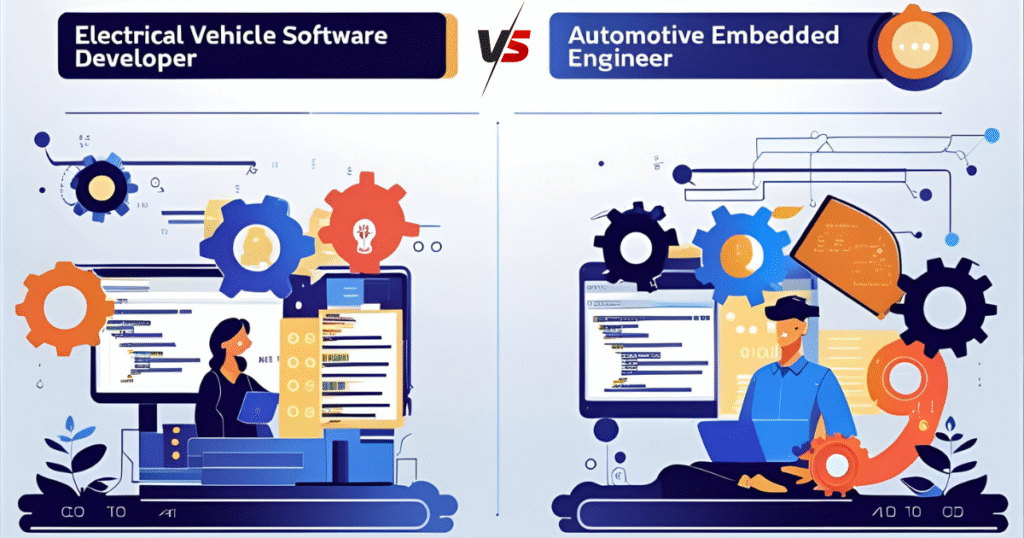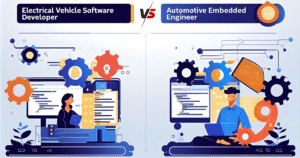
As the automotive industry transitions rapidly toward electrification, software development and embedded systems engineering have taken center stage. However, job roles like Electrical Vehicle (EV) Software Developer and Automotive Embedded Engineer are often misunderstood or used interchangeably. While they may work side by side, their skill sets, responsibilities, and goals differ significantly.
This blog explores the critical differences between these two roles, helping both recruiters and aspiring professionals understand where the lines are drawn and how they contribute uniquely to the electric vehicle ecosystem.
Understanding the Roles
Who is an Electrical Vehicle Software Developer?
An EV Software Developer primarily focuses on building, testing, and maintaining the software systems specific to electric vehicles. Their work covers a broad range of applications, from battery management systems to telematics, infotainment, and vehicle control units.
Key Domains:
- Battery Management Software (BMS)
- Electric Powertrain Control
- Over-the-Air (OTA) Updates
- Telematics & Navigation
- Human-Machine Interface (HMI)
Who is an Automotive Embedded Engineer?
An Automotive Embedded Engineer, on the other hand, works on real-time embedded systems that are integral to all types of vehicles—combustion, hybrid, and electric alike. Their primary job is to write low-level code that interfaces directly with hardware components.
Key Domains:
- Real-Time Operating Systems (RTOS): A lightweight OS designed to process data and execute tasks within strict timing constraints, essential for real-time vehicle control functions.
- Sensor Integration: The process of connecting and configuring hardware sensors (e.g., speed, temperature, proximity) so they can collect and transmit data to a vehicle’s software systems.
- Firmware Development: Writing low-level code that runs directly on hardware microcontrollers to control basic device operations, often in C or assembly.
- ECU Programming: Developing and updating software for Electronic Control Units (ECUs), which manage specific functions like braking, engine performance, or battery systems in vehicles.
- Safety-Critical Systems: Systems where failure could result in harm to people or property, requiring rigorous standards like ISO 26262 for design, testing, and certification.
Key Responsibilities
| Responsibility | EV Software Developer | Automotive Embedded Engineer |
| Software design for EV components | ✅ | ❌ |
| Embedded C/C++ programming | ✅ | ✅ |
| Interfacing with hardware sensors | ✅ | ✅ |
| Developing firmware for microcontrollers | ❌ | ✅ |
| Working on battery algorithms | ✅ | ❌ |
| Compliance with ISO 26262 (Functional Safety) | ✅ | ✅ |
| Integration with cloud/IoT platforms | ✅ | ❌ |
| Diagnostics and logging tools | ✅ | ✅ |
Skills and Technologies Used
EV Software Developer:
- Languages: Python, C++, Java, MATLAB
- Tools: Simulink, CANalyzer, Vector Tools
- Platforms: Linux, QNX, RTOS
- Communication Protocols: CAN, LIN, Ethernet, MQTT
- Cloud Integration: AWS IoT, Azure IoT Hub
- Security: Secure Boot, Encryption, OTA Management
Automotive Engineer:
- Languages: C, Assembly, MISRA C
- Tools: Keil, IAR, Lauterbach, JTAG Debuggers
- Microcontrollers: ARM Cortex-M, Infineon, Renesas
- Real-Time OS: FreeRTOS, AUTOSAR, VxWorks
- Communication: SPI, I2C, UART, CAN
- Compliance: ISO 26262, ASPICE, MISRA Standards
Areas of Overlap
Though the roles are different, they often intersect in the following areas:
- CAN Bus Communication: Both professionals must understand and utilize vehicle networking protocols.
- Testing and Validation: Simulation and Hardware-in-the-Loop (HIL) testing are common responsibilities.
- Safety Compliance: Ensuring software reliability and functional safety is a shared goal.
- Team Collaboration: Both work closely with hardware designers, QA testers, and systems engineers.
Differences in Focus and Specialization
| Aspect | EV Software Developer | Automotive Embedded Engineer |
| Main Focus | High-level vehicle software and apps | Low-level firmware and real-time control |
| Depth of Hardware Interaction | Moderate | Deep |
| Scope | Vehicle-wide systems including UI/UX | Specific subsystems like engine control or sensor modules |
| Domain-Specific Expertise | EV algorithms, energy efficiency | Sensor calibration, memory management |
| End-User Impact | More visible (infotainment, telematics) | Less visible but critical (braking systems, airbag control) |
Industry Demand and Career Path
EV Software Developer Career Path:
- Junior Developer → EV Software Engineer → Lead Software Architect → EV Systems Manager
- Often transitions into Product Management or IoT/AI roles within automotive
Automotive Embedded Engineer Career Path:
- Embedded Engineer → Senior Embedded Systems Engineer → Firmware Lead → Embedded Systems Architect
- May progress into hardware-software co-design or systems safety leadership
Market Trends:
- The demand for EV Software Developers is growing at an exponential rate as OEMs and startups race to launch new electric vehicles.
- Embedded Engineers remain a backbone role for automotive manufacturers, especially those transitioning from ICE to EV platforms.
Collaboration in the EV Ecosystem
These two professionals must collaborate to ensure seamless integration between hardware and software in EVs:
- EV Developers define functional behavior, and Embedded Engineers ensure real-time execution of that behavior.
- When a new feature like regenerative braking is introduced, EV developers model it, while embedded engineers make it run smoothly on hardware.
Effective collaboration = Efficient performance + Safe vehicle operation.
Conclusion
While an Electrical Vehicle Software Developer and an Automotive Embedded Engineer may appear to operate in similar spaces, their core functions diverge based on the level of abstraction, hardware dependency, and target components within a vehicle. Understanding these distinctions is critical for building balanced teams in the rapidly evolving electric mobility sector.
If you’re looking to hire or become one of these professionals, define your project scope clearly and choose a role that aligns with your technical objectives.
FAQs
Q1. Can an embedded engineer become an EV software developer?
Yes. With upskilling in high-level programming languages, EV system architecture, and cloud technologies, an embedded engineer can transition into an EV software role.
Q2. Which role pays more?
It depends on the market, but EV Software Developers often command higher salaries due to their cloud integration and systems-level design skills.
Q3. Do both roles require knowledge of functional safety?
Absolutely. ISO 26262 and other safety standards are essential for both roles, particularly in mission-critical automotive systems.
Q4. Do both roles need to understand CAN protocol?
Yes. CAN (Controller Area Network) is a foundational communication protocol in vehicles, and both roles need to interpret CAN messages.
Q5. Which role is more suitable for working on autonomous driving?
Both are important. However, EV Software Developers are typically more involved in higher-level systems like ADAS, AI, and sensor fusion algorithms.







